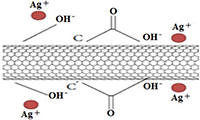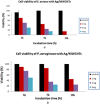Cytotoxicity properties of functionalised carbon nanotubes on pathogenic bacteria
- PMID: 31432792
- PMCID: PMC8676435
- DOI: 10.1049/iet-nbt.2018.5394
Cytotoxicity properties of functionalised carbon nanotubes on pathogenic bacteria
Abstract
Nanobiotechnology is a promising field concerned with the using of engineered nanomaterials, which leads to the improvement of new human remedial against pathogenic bacteria modalities. In this work, silver nanoparticles (AgNPs) were prepared by an easy, cheap and low-cost electro-chemical method. The AgNPs were then loaded successfully on to multi-walled carbon nanotubes (MWCNTs) using a modified chemical reaction process. The AgNPs on the MWCNTs were well spread and evenly distributed on the surfaces of the long nanotubes with well-graphitised walls as examined by high-resolution transmission electron microscopy. X-ray diffraction and transmission electron microscopy were used for sample characterisation. Good dispersion of AgNPs was obtained on the surface of MWCNTs, resulting in an efficient reactivity of the carbon nanotubes surfaces. Finally, the antibacterial activity of AgNPs/MWCNTs hybrid was evaluated against two pathogenic bacteria Pseudomonas aeruginosa and Staphylococcus aureus exhibited excellent activity.
Figures








References
-
- Frimmel F.H. Reinhard N.: ‘Nanoparticles in water cycle’ (Springer‐Verlag, Berlin, 2010)
-
- Haider A.J. AL‐Anbari R.H. Kadhim G.R. et al.: ‘Exploring potential environmental applications of TiO2 nanoparticles’, Energy Procedia, 2017, 119, pp. 332 –345
-
- Savage N. Diallo M.S.: ‘Nanomaterials and water purification: opportunities and challenges’, J. Nanoparticle Res., 2005, 7, (4–5), pp. 331 –342
-
- Kevin Dreher L.: ‘Health and environmental impact of nanotechnology: toxicological assessment of manufactured nanoparticles’, Toxicol. Sci., 2014, 77, pp. 3 –5 - PubMed
MeSH terms
Substances
LinkOut - more resources
Full Text Sources
Medical

